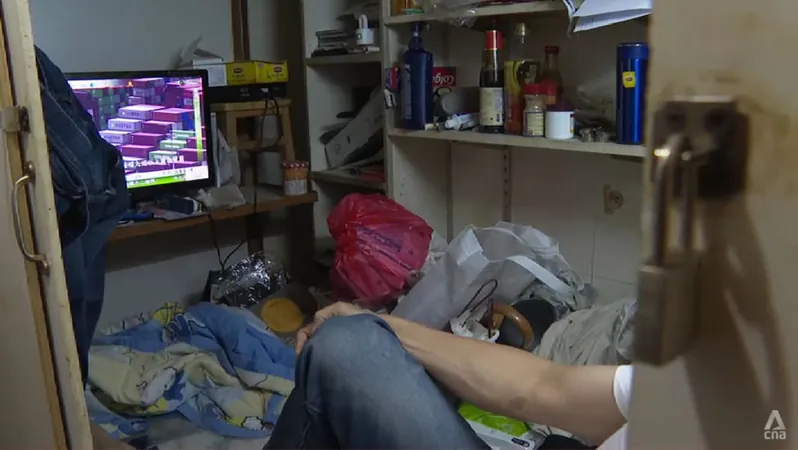
Will Hong Kong's Move to Phase Out Shoebox Homes Actually Help the City's Impoverished?
2024-12-04
Author: Ting
Introduction
In a bold political initiative, Hong Kong Chief Executive John Lee has announced plans to phase out the notorious "shoebox homes," officially known as subdivided flats, which have long been synonymous with the city’s housing crisis. This new policy has ignited debates across the region, raising questions about its effectiveness in improving living conditions for the underprivileged.
Subdivided Flats: The Last Resort
Subdivided flats have played a significant role in Hong Kong’s rental landscape, often serving as the last resort for low-income families. These cramped living spaces typically house unrelated individuals, leaving tenants with barely sufficient room for basic living needs. Many units are conveniently situated near essential amenities, such as wet markets, public transportation, and schools, thereby adding to their appeal despite their appalling living conditions.
Current Situation of Subdivided Flats
Recent data from the Hong Kong Census Department indicates that there are approximately 108,000 subdivided units in the city, accommodating over 200,000 people. Each unit averages just 11 square meters, translating to a meager per capita area of only 6 square meters. Such living conditions are not just cramped; they are unfit for human habitation.
Government Regulations and Compliance
Under the new regulations, the government plans to enforce minimum living standards for these subdivided units. Landlords will need to provide essential features such as windows, individual toilets, and a minimum floor space of at least 8 square meters. The government aims to provide a grace period for landlords to comply with these new requirements, during which these units will be reclassified as Basic Housing Units.
Response from Officials
Positive news has emerged from Deputy Financial Secretary Michael Wong, who stated that around 70% of existing subdivided flats already meet the forthcoming standards. Nonetheless, many units will require minor renovations to align with the regulations. Wong envisions a gradual phase-out of these substandard housing solutions, complemented by the anticipated increase in public rental housing.
Challenges Ahead
The challenge remains, however, as the waiting list for public housing is notoriously long. Mr. Lee noted the construction of 30,000 new public housing units to be completed by 2028, but with over 123,100 families and elderly applicants already waiting, the journey to secure adequate housing continues to be a daunting task. The current waiting time for families stands at around 5.5 years, with hopes to reduce it to 4.5 years by 2027.
Overlooked Tenants
Moreover, a significant portion of subdivided flat tenants—while eligible for public housing—may still fall through the cracks in this housing solution. Wong estimates that about 60% of the subdivided flat tenants qualify for public rental housing, leaving 40% of the occupants potentially stranded without affordable housing options. If these individuals cannot secure public rental housing, they will face the harsh reality of escalating private rental rates.
Vulnerable Populations at Risk
The 2021 Census data also reveal that 21.2% of households contain at least one member who has lived in Hong Kong for less than seven years, disqualifying them from many social benefits. As regulations tighten around subdivided flats, this group may find themselves in a perilous position, left to navigate a landscape of increasing housing demands and inadequate options.
Economic Implications
With the government’s new measures, tenants in non-compliant subdivided units might see shockingly higher rents, as landlords are required to reduce the number of units within their properties. There is uncertainty about whether the government can provide transitional housing for those displaced under the new regulations, pushing many to the fringes of the illegal rental market.
Community Concerns
Housing advocacy groups are understandably concerned about the displacement of tenants. ComHome Social Realty, an organization dedicated to assisting low-income households in finding affordable housing, has reported a disheartening success rate. Since its establishment in 2023, only 17 out of 300 participants have successfully found housing—an evident reflection of the financial mismatch between their resources and existing rental costs.
Current Housing Costs vs. Income
Recent figures reveal that the median rent for subdivided flats reaches HK$7,000 on Hong Kong Island and HK$5,300 in Kowloon. Meanwhile, the average monthly income for tenants of subdivided flats rests at HK$16,160, forcing many to allocate as much as 50% of their income just to secure a roof over their heads.
Conclusion
While the 2024 policy framework represents a concerted effort by the Hong Kong government to tackle its housing crisis, the path ahead remains fraught with challenges. The introduction of Basic Housing Units marks a new venture; however, the glaring imbalance between housing demand in central districts and the shortage of affordable options poses significant hurdles for the city’s most vulnerable communities.
As advocacy for affordable housing persists, many are left to wonder: Will these new regulations bring about real change, or will they simply lead to further struggles for Hong Kong’s impoverished residents? Only time will tell as the city grapples with this pressing issue.



 Brasil (PT)
Brasil (PT)
 Canada (EN)
Canada (EN)
 Chile (ES)
Chile (ES)
 Česko (CS)
Česko (CS)
 대한민국 (KO)
대한민국 (KO)
 España (ES)
España (ES)
 France (FR)
France (FR)
 Hong Kong (EN)
Hong Kong (EN)
 Italia (IT)
Italia (IT)
 日本 (JA)
日本 (JA)
 Magyarország (HU)
Magyarország (HU)
 Norge (NO)
Norge (NO)
 Polska (PL)
Polska (PL)
 Schweiz (DE)
Schweiz (DE)
 Singapore (EN)
Singapore (EN)
 Sverige (SV)
Sverige (SV)
 Suomi (FI)
Suomi (FI)
 Türkiye (TR)
Türkiye (TR)
 الإمارات العربية المتحدة (AR)
الإمارات العربية المتحدة (AR)